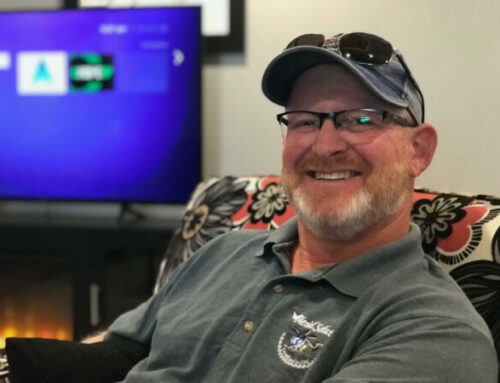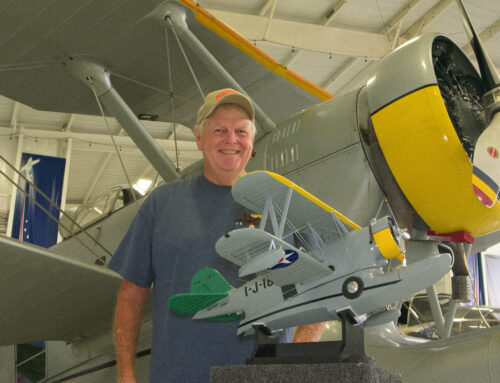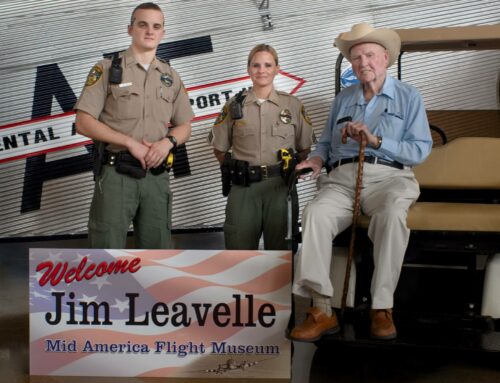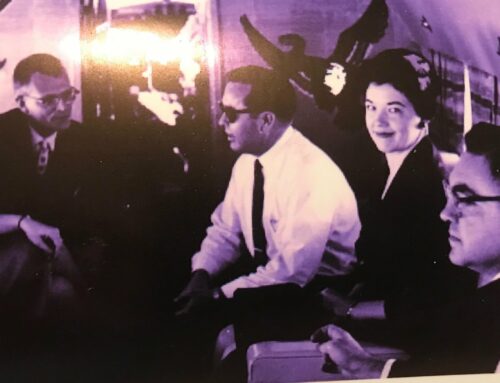Meeting Mayo, Part II of III by W.P. Minor
Straightway, I was shown a few pictures Mayo and I had previously discussed. The first was a photograph of his late wife Mary at about six years of age. The thought occurred to me, that she could have been Darla from the old Little Rascals television series. She was standing beside the door of a 1936 Stinson Trimotor, a high winged version. The picture had been taken when she made a flight from Waco to Dallas. He said it had been just before she and her family had moved to Texarkana.
It was while living in Texarkana at a very young age, Mary would attend the Patty Hill School. Patty Hill was a private school where notable H. Ross Perot, only little older than her, also attended. Mary would later move back to Longview where she would inadvertently cross paths with her future husband, Mayo Lanagan although neither had a clue at the time.
Mayo said when on his 12th birthday in 1942, his mother took him to a “photography shop” as Mayo called it, which turned out to also be where the photographer and his family lived. While there, he had seen an auburn-haired girl of about his age, sitting on the front porch.
Later on, Mayo said he had a school teacher who required the students to make some type of report on current events. He said he made his report on what he had seen in the comic section of the newspaper but there was a girl sitting somewhere behind him who produced a somewhat more polished report. He heard the teacher tell her “That was very good Mary.” Turning to see the recipient of the compliment, he discovered, it was the very same girl he had seen sitting on the steps of the photography shop. “That,” he said, “was how I found out what her name was.”
Mayo said it was on “D-Day, June 6th, 1944” that he and Mary Fort graduated “into” high school together. He said it was about then that he learned, Mary was two years younger than he was but she had been a “brilliant student.” Mary had been advanced two grades which might have been to some extent, a byproduct of having attended the Patty Hill School in the early years. This promotion was somewhat held against her though, Mayo said the administrators of the school felt that Mary at only 15 years of age, was too young to be allowed into college with so many of the then students being significantly older; some of them he said, were World War II veterans who were attending college under the G.I. Bill.
Mayo had at one point, moved to Beaumont with his mother and after high school, attended a few years at Lamar University. He said he and Mary reacquainted around January of 1950 and in March of that year, they were married.
Mayo spoke of his early years in Longview. Coinciding with Mary having ridden in a Trimotor as a child, he too had ridden in a Ford Trimotor when he was around 6 years old. By then, I had previously seen a video recording of Mayo’s 80th birthday party where he had mentioned riding as a child, holding on to wicker seats, in a Ford Trimotor. He had described the pilot as being “scruffy” and the Trimotor as “Scruffier.” I asked Mayo about that experience and he explained that his father had been the manager of some movie theater in Longview and the airplane had traveled to Longview as a way of promoting some movie released that year (1936).
I had snooped around and found that the screen adaptation of Flash Gordon had gone to film that year and although it was made as a series, in 1936, Universal Studios released “The Planet of Peril” staring Buster Crabb. There had been other aviation-themed movies released in 1936 including “Ceiling Zero” starring James Cagney. It was Planet of Peril, however, that had a Ford Trimotor being flown in a dramatic scene where meteors rained down on the earth threatening the passengers in a Trimotor. Mayo said he had boarded the Trimotor at the East Side Airport where they took off on a runway that today, is grown up with trees.
Mayo said in the early 1930s, the East Texas Oil Boom had really taken off and it had been difficult to find a property to live. He said it was almost impossible to find housing in Longview at the time so his father had moved the family into one of the old dressing rooms at an old theater called “The Rembert.” The Rembert had originally opened in 1883 as an Opera House and became “The Rembert Theater” in 1916, with seating for nearly 900 patrons. It stood at 204 East Cotton and was open through 1957 and was afterward demolished. During the period of living at The Rembert, Mayo said his father purchased a tract of land out on Judson Road where he built a home for the family.
As a young married man, Mayo had needed a job and had become a reporter and photographer for the Longview News-Journal where he worked for Ellie Hopkins, the Chief Editor for the paper. He later obtained a job with Bell Telephone in Tyler, TX for a couple of years but said there was no money with Bell until after you put in a good “forty years or so” Mayo said, laughingly. He said that his former Chief Editor Ellie Hopkins, who had been on the board of directors for Lone Star Steel, had contacted him and asked him if he would be interested in becoming taking the public relations position for the Lone Star Steel Company and he jumped at the chance.
Mayo hired on with Lone Star Steel, a private company at the time on the week of July 4th, 1953. It was on that day, that the mill produced its first steel. Prior to then, Mayo said, the company had made cast pipe and pig iron. The plant’s site near Lone Star had initially been selected because the concentrated geographic locations of the steel mills in the northeast, made them an easy target for an attack.
This propelled the need to geographically diversify foundries and the like across the country but the plant never become active during WWII. Operations by the Defense Plant Corporation were conducted for a time but eventually, the site was sold off to a group of investors. A congressional proponent of the sale, Wright Patman, had been on hand for the signing of the contracts of sale which were executed in the area of the pine trees where the little chapel is now located in front of the plant. E.B. Germany was appointed the first C.E.O. and coined the name “Lone Star Steel.”
END OF PART II









Leave A Comment